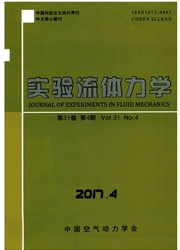

 中文摘要:
中文摘要:
超疏水壁面由于具有减阻和自清洁功能而成为国内外减阻和海洋防污等研究领域的热点之一,而20世纪湍流中相干结构的发现为湍流的控制指出新的方向,尤其近壁区涡结构对摩擦阻力贡献很大.利用高时间分辨率粒子图像测速技术,研究了超疏水壁面(SH)以及亲水壁面(PH)湍流边界层中正负展向涡的空间分布特征,研究逆向涡对超疏水壁面近壁区流动结构的影响和超疏水壁面的减阻机理.首先利用空间多尺度局部平均涡量的概念提取壁湍流发卡涡展向涡头(顺向涡)和逆向涡,实现了准确识别涡心并排除小尺度涡的干扰;然后根据检测到的顺向涡和逆向涡流线分布图,发现逆向涡始终处于正向涡的上游和下方,并且对正向涡的进一步发展起抑制作用;最后对两种壁面边界层中逆向涡数量以及出现概率进行对比,发现具有减阻效果的超疏水壁面边界层中出现更多逆向涡.说明逆向涡可抑制上方顺向涡与壁面的强烈剪切,并使靠近壁面的流体加速,从而产生减阻效果;超疏水壁面中涡结构具有更大的β角,使其更好地阻碍了发卡涡头附近强烈的喷射和扫略;超疏水壁面逆向涡出现概率明显大于亲水壁面.这些结果表明:超疏水壁面表现出的减阻特性(Reδ≈13 500,减阻5.8%)与两板产生逆向涡的差异有关.
 英文摘要:
英文摘要:
The discovery of coherent structures in turbulent in the last century suggests a new direction for turbulent controy, especially the vortex in the near-wall region, which has a great contribution to the skin friction. In this study, the spanwise vortex characteristics, compared between superhydrophobic(SH) surfaces and hydrophilic(PH) surfaces in the turbulent boundary layer, were investigated by time-resolved particle image velocimetry(TRPIV). Firstly, the multi-scale spatial locally-averaged vortices were utilized to extract the spatial topologies of the spanwise vortex head(clockwise vortex) and retrograde vortex, and this method accurately identified the vortex core and excluded the interference of the minor scales vortex. Secondly, the distributions of streamline around clockwise and retrograde vortex visualized vortex structure properly to study relative position relation between the two kinds of vortex. Finally, through the comparative research on the number of retrograde vortex, for SH surfaces, the occurrence probabilities of retrograde vortex seems to be bigger than SH surfaces. There is a conclusion that retrograde vortex can inhibit the development of the corresponding clockwise vortex and restrain its strong ejection and sweep events. Accelerating the fluid in the near-wall region is also the direct cause for the drag-reduction effect of SH surfaces. These show that the drag-reduction effect(approximately5.8% when Reδ ≈ 13 500) of SH surfaces is related to the differences of retrograde vortex.
 同期刊论文项目
同期刊论文项目
 同项目期刊论文
同项目期刊论文
 期刊信息
期刊信息
